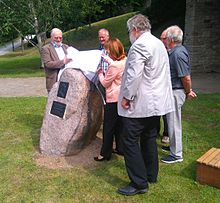Bismarck Monument (Wernigerode)
The Bismarck memorial in the town of Wernigerode in the Harz district in Saxony-Anhalt is located on Lindenallee at Lustgarten not far from the memorial to those who fell in the German and Franco-German Wars .
Bismarck monuments were erected in the German Reich, founded in 1871, in honor of the long-standing Prussian Prime Minister and first German Chancellor, Prince Otto von Bismarck, in many central locations, but also in the colonies of that time and on other continents. They were the most visible and lasting expression of Bismarck's admiration in the German Empire and beyond. The size and complexity of the realized monuments range from simple memorial plaques and reliefs to extensive systems with several groups of figures. Bismarck monuments were often directed "against the theatrical power pathos of Wilhelminism".

The first Bismarck monument was not erected in the city of Wernigerode, but in the suburb of Nöschenrode on the Harburg, an excursion restaurant with a view of the castle and city of Wernigerode. The 2.60 meter high bronze monument was unveiled on April 1, 1890. It was a replica of the monument for Bad Kissingen created by the sculptor Heinrich von Manger from Berlin in 1877 . The innkeeper W. Bitterling from Magdeburg bought this copy and had it set up for a few years in the garden of the restaurant “Zum Hofjäger” he ran. After the inn was closed, Bitterling donated the monument to the then still independent community of Nöschenrode, which organized its implementation and repositioning on the Harburg on a resin granite base.
On November 2, 1955, the monument that no longer fits the time was removed by order of the SED district leadership in Wernigerode.
After German reunification , a new Bismarck memorial was erected in the same place in 1998 by the CDU city council group chaired by Jörg Rische. It was a relief portrait of Bismarck and a memorial plaque. This monument was destroyed by metal thieves after a few years.
A similar memorial was erected on July 30, 2016, the 118th anniversary of Bismarck's death, on Lindenallee in Wernigerode on the initiative of Jörg Rische and Konrad Breitenborn and the Harz Club, and was ceremoniously unveiled by Heike Brehmer, member of the CDU .
Text of the plaque
Otto von Bismarck
April 1, 1815 - July 30, 1898
on his 200th birthday
In memory of
the Harz wanderer, unifier and
founder of the German welfare state
Bismarck and Wernigerode
As a student in Göttingen, Bismarck first joined some students from Mecklenburg , with whom he went on a hike through the Harz Mountains after the Hambach Festival in May 1832 . After his return he received his first reprimand from the university court for throwing a bottle out of the window of the Göttingen hotel restaurant Krone on Weender Strasse in a relaxed mood .
On his second trip to the Harz Mountains, he also visited Wernigerode and the Brocken and got closer to his future wife Johanna von Puttkamer . Johanna was a close friend of Marie von Thadden's . It was she who steered Bismarck towards her friend Johanna von Puttkamer. Already at the Blanckenburg wedding on October 4, 1844, the first meeting between Otto von Bismarck and Johanna von Puttkamer was deliberately prepared. But with Bismarck no spark seemed to ignite. Moritz urged him: “Come and see! If you don't want her, I'll take her to my second wife. ”It was almost two years before Otto von Bismarck came into a closer relationship with Johanna von Puttkamer. The couple finally got closer on a trip to the Harz Mountains they shared with the Blankenburgs.
Bismarck knew the lord of the castle of Wernigerode, Count Otto zu Stolberg-Wernigerode , from the time he was his deputy as German Chancellor. The relationship between the two had cooled down considerably over time, so that after Otto's resignation to Stolberg-Wernigerode there was no personal meeting between the two at Wernigerode Castle .
The monument to Prince Otto zu Stolberg-Wernigerode, which was completely removed after 1945, stood just a few meters from the current location of the Bismarck monument in Wernigerode, which was built in 2016, at the end of the staircase leading to the Lustgarten.
literature
- Sieglinde Seele: Lexicon of the Bismarck Monuments . Michael Imhof, Petersberg 2005, pp. 405-406 ISBN 3-86568-019-4 .
Individual evidence
- ↑ Thomas Nipperdey: German History 1866-1918 . Bd. II. Power state before democracy. Beck, Munich 1992, p. 599 f.
- ↑ Sieglinde Seele: Lexicon of Bismarck Monuments . Petersberg 2005, p. 406.
- ^ Ivonne Sielaff: Metal thieves plundered Bismarckstein . In: Harzer Volksstimme, edition of June 3, 2015
- ↑ The Mecklenburg Corps Vandalia Göttingen had suspended in 1831 and did not reopen until 1833
- ↑ See Eyck, Vol. 1, page 125
Coordinates: 51 ° 50 ′ 0.2 ″ N , 10 ° 47 ′ 43.4 ″ E
